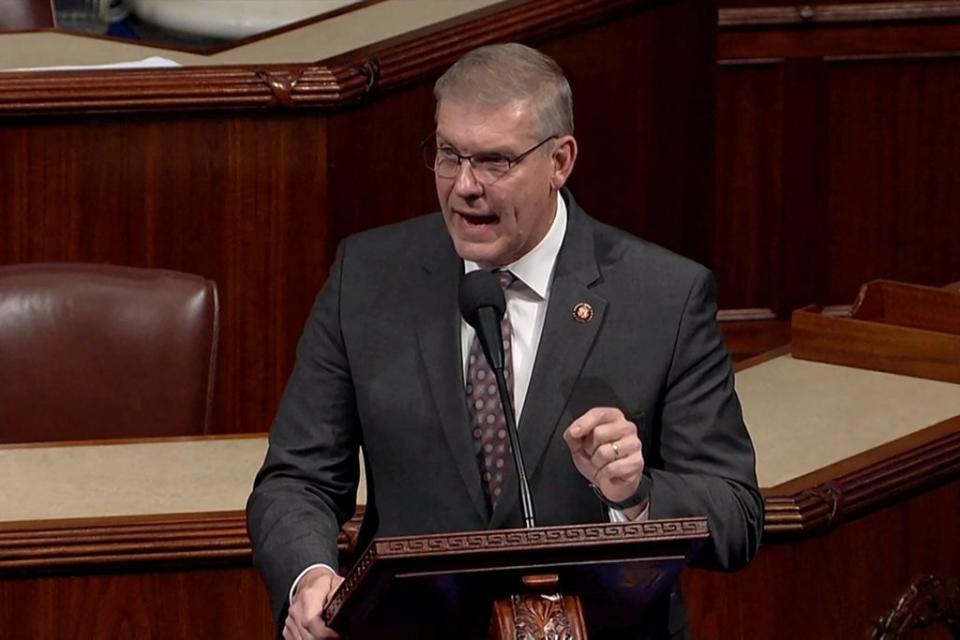Jan 6 committee says it has evidence of GOP-led ‘reconnaissance’ tours
The House select committee investigating the 6 January 2021 attack on the Capitol appears to have obtained evidence showing at least one Republican member gave an unauthorised tour on the day before a mob of former president Donald Trump’s supporters stormed the building.
In a letter to Georgia Representative Barry Loudermilk, select committee chairman Bennie Thompson and vice-chair Liz Cheney informed Mr Loudermilk, a Georgia Republican, that the nine-member panel has obtained information regarding a tour he allegedly led on the eve of the attack on the Capitol.
“The foregoing information raises questions to which the select committee must seek answers,” they said.
In May 2021, Mr Loudermilk led a group of Republicans on the House administration committee who filed an ethics complaint against New Jersey Representative Mickie Sherrill, a Democrat, after she alleged that Democratic members and staff “witnessed an extremely high number of outside groups” in the Capitol complex on 5 January 2021.
Ms Sherrill and 33 other Democrats also alleged that many of the “visitors” they encountered the day before the riot “appeared to be associated” with the White House rally at which Mr Trump urged his supporters to “fight like hell” just before a group of them began assaulting Capitol Police, and noted that the rioters “seemed to have an unusually detailed knowledge of the layout of the Capitol Complex”.

In the complaint, Mr Loudermilk alleged that “no Republican Member of Congress led any kind of ‘reconnaissance’ tours through the Capitol on any date, including January 5, 2021” and called the allegations made by Ms Sherill “false”.
In February, Republicans on the House administration committee — including Mr Loudermilk — also sent a letter to House Speaker Nancy Pelosi claiming they had “reviewed the security footage from the Capitol Complex during the relevant period preceding January 6, 2021“ and said they “[knew] it [did] not support these repeated Democrat accusations about so-called ‘reconnaissance’ tours”.
But in their Thursday letter to Mr Loudermilk, Mr Thompson and Ms Cheney said the panel’s “review of evidence directly contradicts that denial”.
It’s unclear whether Mr Loudermilk, who is in his fourth term representing Georgia’s 11th District, will appear for the 23 May interview requested by Mr Thompson and Ms Cheney or cooperate with the panel’s investigation in any way.
Other Republican representatives who have been asked to cooperate with the committee’s probe — including House Minority Leader Kevin McCarthy — have denounced the investigation as illegitimate and have refused to provide the committee with any information.
But the revelation that the select committee has obtained information about tour conducted the day before the 6 January attack indicates it may have solved one of the most enduring mysteries from that tumultuous day.
Although the Capitol and the House and Senate office buildings connected to it are notoriously difficult to navigate, the mob of Mr Trump’s supporters appeared to move about the labrynthine complex with ease after entering through broken windows and forced doors.
One group ransacked the office of the Senate’s parliamentarian, where staffers would have normally had custody of the electoral vote certificates which were being counted at the joint session of congress that the riot temporarily delayed.
Members of the violent extremist group known as the Oath Keepers appeared to be familiar with the byzantine network of tunnels which runs beneath the Capitol and its adjacent office buildings.
In court documents, prosecutors have alleged that one member of the group sent an encrypted message during the attack which told co-conspirators that lawmakers were “in the tunnels under the capital [sic]” and urged the recipient to “seal them in” and “turn on gas”.
Another message sent as House members were being relocated to a secure location informed the accused insurrectionist that “all legislators” were “down in the tunnels, [three] floors down”.
Rioters were also able to find their way to the private offices of some high-ranking lawmakers — colloquially known as “hideaways” — even though the doors of such offices are unmarked and their locations closely-guarded.
The ease with which the pro-Trump mob made its way through the Capitol has left many lawmakers and staff with suspicions that the rioters had been given information on key locations within the complex.
Representative James Clyburn — the third-ranking House Democrat — told CBS News he believed “something was going on” that day because rioters “knew where to go” in an interview days after the attack.
Mr Clyburn said he believed his private office in the Capitol was targeted by the pro-Trump rioters because there had been "activity outside of my inner office where most people don't know where that is”.
"The office with my name on the door was not touched. But the office where I do most of my work in, they were on that floor and outside that door," he said.
Mr Clyburn said other members had told him of hearing that staffers “ saw people being allowed into the building through side doors”.
In the days following the riot, several GOP members, including Representatives Marjorie Taylor Greene, Lauren Boebert, and Madison Cawthorn, were accused of leading the “reconnaissance” tours referenced by Ms Sherrill in the 13 January letter.
Ms Boebert, a first-term representative from Colorado, also drew scrutiny for having tweeted out that Ms Pelosi had been evacuated from the House floor as rioters stormed the building, with one group heading directly for the Speaker’s private offices on the Capitol’s first floor.
All three have denied giving tours to any rioters the day before the riot.

 Yahoo News
Yahoo News 
